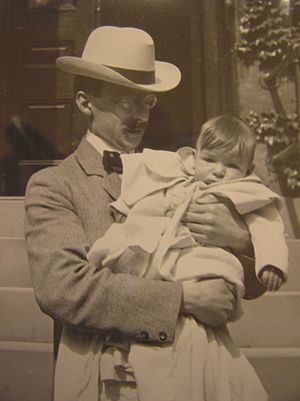Gilbert Hovey Grosvenor facts for kids
Quick facts for kids
Gilbert Hovey Grosvenor
|
|
|---|---|
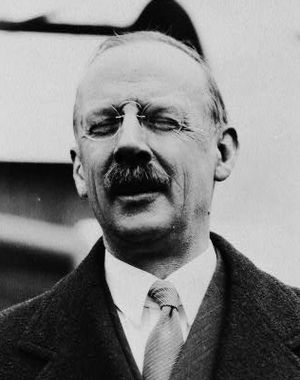
Grosvenor, 1927
|
|
| President of the National Geographic Society | |
| In office 1920–1954 |
|
| Preceded by | John E. Pillsbury |
| Personal details | |
| Born | October 28, 1875 Constantinople, Ottoman Empire (now Istanbul, Turkey) |
| Died | February 4, 1966 (aged 90) Cape Breton Island, Nova Scotia, Canada |
| Resting place | Rock Creek Cemetery |
| Spouse |
Elsie May Bell
( |
| Children |
|
| Parents | Edwin A. Grosvenor Lilian Waters |
| Relatives | Alexander Graham Bell (father-in-law) Mabel Gardiner Bell (mother-in-law) William Howard Taft (second cousin) Walter Kendall Myers (grandson) |
| Education | Worcester Academy |
| Alma mater | Amherst College |
Gilbert Hovey Grosvenor (October 28, 1875 – February 4, 1966) was a very important person in the history of National Geographic magazine. He was its first full-time editor from 1899 to 1954. Many people say he helped make National Geographic the famous magazine it is today.
He also became the President of the National Geographic Society. This organization helps people learn about science and the world. Under his leadership, the Society grew a lot. Its magazine shared amazing stories and photos of explorations from all over the globe.
Contents
Early Life
Gilbert Hovey Grosvenor was born on October 28, 1875. His parents were Lilian Waters and Edwin A. Grosvenor. He was born in Constantinople, which was part of the Ottoman Empire. Today, this city is called Istanbul in Turkey.
He was a second cousin to William Howard Taft. Taft later became a U.S. President and a U.S. Supreme Court Justice.
Gilbert went to Worcester Academy and Robert College. He then studied at Amherst College and graduated in 1897. While at Amherst, Gilbert and his twin brother Edwin were excellent tennis players. They were one of the best doubles teams.
Career at National Geographic
Starting at National Geographic
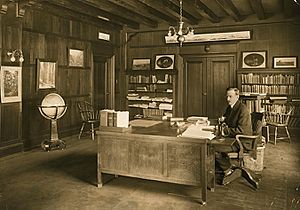
In 1899, Alexander Graham Bell hired Gilbert Grosvenor. Bell was the President of the National Geographic Society at that time. Gilbert was the very first full-time employee of the Society.
He became the Director and then was elected President of the Society in 1920. He also continued to be the editor of National Geographic magazine until 1954. That means he led the magazine for 50 years!
His Vision for the Magazine
Gilbert Grosvenor believed in showing the good side of the world. He wanted the magazine to be neutral and positive. He kept this style even during two world wars and the Great Depression. This way of reporting was new and exciting in the early 1900s.
After many years, the magazine needed new ideas. Gilbert stepped down in 1954 when he was 78 years old.
Helping Create National Parks

In 1915, Gilbert Grosvenor visited the western United States. He hiked in the Sierra Mountains with Stephen Mather. Mather was a very important person in creating national parks. Gilbert was so amazed by the beauty of the mountains. He became a strong supporter of national parks.
When he returned, Gilbert helped buy land for Sequoia National Park. For a long time, it was hard to create a national park system. In 1915 and 1916, Gilbert met with Stephen Mather and others. They worked together to write a law called the National Park Service Organic Act. This law would create the National Park Service.
Gilbert then made a special issue of National Geographic in April 1916. It was called "The Land of the Best." This issue showed how important parks were. It asked readers to support the idea of a national park system. Gilbert made sure every member of Congress received a copy. Their hard work paid off, and the law to create the National Park Service passed that year.
Gilbert continued to help the National Parks. He worked to protect the Katmai volcanic crater in Alaska. He helped create Katmai National Monument in 1918. Today, a lodge in Katmai National Park is named after him. It is called Grosvenor Lodge.
Personal Life
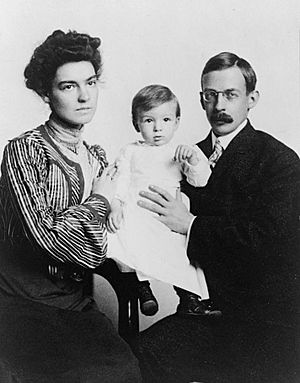
Gilbert Grosvenor married Elsie May Bell (1878–1964). Elsie was the daughter of the famous inventor Alexander Graham Bell. Gilbert and Elsie had seven children:
- Melville Bell Grosvenor (1901–1982), who also became a president of National Geographic Society.
- Gertrude Hubbard Grosvenor (1903–1986).
- Mabel Harlakenden Grosvenor (1905–2006), who was a doctor for children. She also worked as a secretary for her grandfather, Alexander Graham Bell.
- Lilian Waters Grosvenor (1907–1985).
- Alexander Graham Bell Grosvenor (1909–1915), who passed away young.
- Elsie Alexandra Carolyn Grosvenor (1911–2004).
- Gloria Victoria Grosvenor (1918–1972).
In 1931, Gilbert bought a home in Coconut Grove, Florida. He named his estate Hissar, after the town in Turkey where he was born. He also served on the Board of Trustees for the University of Miami from 1944 to 1960.
Gilbert Grosvenor passed away peacefully in his sleep on February 4, 1966, at the age of 90. He is buried in Rock Creek Cemetery with his wife and members of the Bell family. Grosvenor Arch, a beautiful rock formation in Utah, is named after him.
Family Legacy
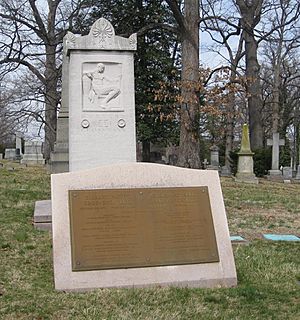
Through his son Melville, Gilbert was the grandfather of Gilbert Melville Grosvenor (born 1931). Gilbert Melville also became a president of National Geographic. Another grandson, Edwin S. Grosvenor (born 1951), is an editor.
Gilbert Grosvenor was one of the people who started the Cruising Club of America. He is also known as the "father of photojournalism." This means he helped make photographs a very important part of telling stories in magazines.
His daughter Mabel helped take care of Alexander Graham Bell's estate in Baddeck, Nova Scotia. She was also the honorary president of the Alexander Graham Bell Club. This club is Canada's oldest women's club.
See also
 In Spanish: Gilbert Hovey Grosvenor para niños
In Spanish: Gilbert Hovey Grosvenor para niños


